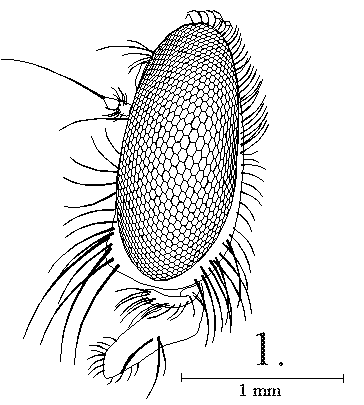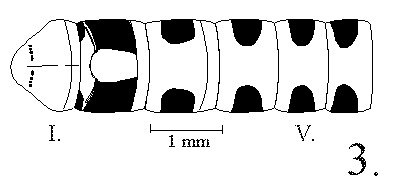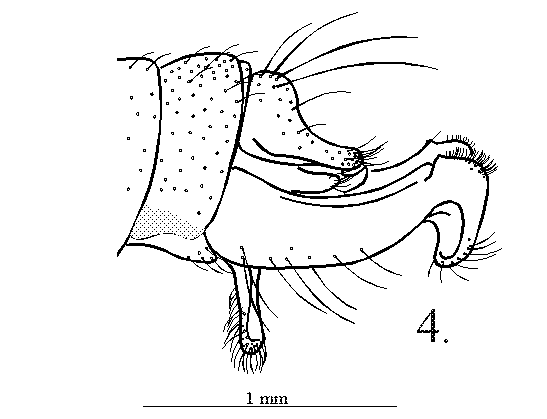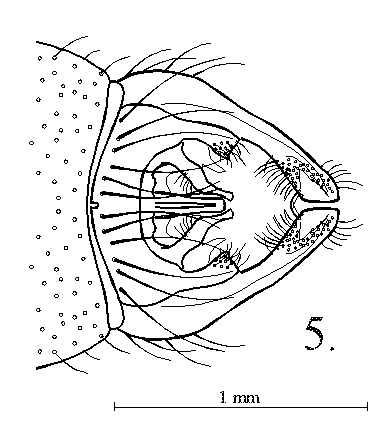
A new species of Damalis FABRICIUS
from Sri Lanka (Diptera: Asilidae)
[Eine neue Damalis-Art aus Sri Lanka (Diptera: Asilidae)]
by
Fritz Geller-Grimm
Frankfurt a.M. (Germany)
(1997)
[Published in: Studia Dipterologica 4(1): 197-200, Halle an der Saale]
Abstract
Damalis kassebeeri spec. nov. is described from Sri Lanka and illustrated. It is compared with the three other species known from Sri Lanka, and a key for these species is given.
Key words: Diptera, Asilidae, Damalis, spec. nov., Oriental, Sri Lanka, key
Zusammenfassung
Damalis kassebeeri spec. nov. aus Sri Lanka wird beschrieben und illustriert. Die Unterschiede der von Sri Lanka bekannten Arten werden in einem
Schlüssel herausgearbeitet.
Introduction
Among some Asilidae from Sri Lanka recently sent to me for identification, I found a number of specimens of the genus Damalis FABRICIUS. Comparison with the species from this and adjacent areas listed in the Oriental Catalogue (JOSEPH & PARUI 1984a) and more recent papers shows that it is a new species which is described herewith.
Description
Damalis kassebeeri spec. nov.
Male (Holotype)
Body length: 10 mm; wings: 8.5 mm. Measurements according to LONDT (1989).
Head black, yellow-brown below pruinose antenna, dark bronze above. Antenna black with black hairs and brownish tomentum; scape inserted in a pit, with one long bristle ventrally; arista about 6 times as long as segment 3 (= 1,5 mm), tip pale. Eye: face width ratio = 2,0 (eye width : face width). Face flat, lower part slightly gibbose, with a horizontal groove above antenna. Mystax composed of several weakish, black bristles on lower half of face, reaching antenna, upper bristles of beard directed upwards; several black postocellar setae. Vertex with pale hairs, some blackish at top, back of head with grey tomentum, post-genal beard white. Proboscis short, with brown hairs apically and one stout bristle at middle. Palpi dark brown with white hairs (Fig. 1).
Thorax black, only anatergite, anepimeron and postpronotal lobe pale reddish. Mesoscutum dark bronze tomentose, an indistinct middle line and two spots at transverse suture (front and back) shining blackish and without tomentum; sides and area in front of scutellum pale brown tomentose; all erect hairs on disc black, as long as combined lenght of antennal segments 1 + 2, at sides longer and thicker; dorsocentrals finer and longer than length of arista, anterior shorter; acrostichals not distinguishable from other hairs. Length: height ratio of scutum = 1,5. Pleura white tomentose, except for a shining area on anepisternum, with several pale hairs; meropleurite with long blackish bristles in front of yellow haltere, which is brownish on knob. Scutellum black and pale tomentose, hind margin and a short median line shining black; all hairs and bristles black, on disc with only a few hairs, hind border with hairs and 6 erect bristles.
Legs yellowish-brown; coxa black with white tomentum; trochanter black; legs on posterior surfaces yellow with black areas: all femora yellow only at base (fore femur at 1/3, hind femur at 1/6), all tibiae blackish ventrally; legs on anterior surfaces completely yellow except for black knees and the darker hind leg; tarsal segments distally dark; clothing hairs of fore and mid legs pale, hind leg with black hairs, fore and mid legs ventrally with long pale hairs; all bristles black, hind femur ventrally with 2 rows of setae (length = 2,5 mm); mid tibia lacking obvious processes.
Wings infuscated (by dense microtrichia) along anterior border and tip (Fig. 2).
Abdomen with a complete postmetacoxal bridge. Abdomen slightly club-shaped, shining black, bearing short blackish hairs (shorter than pedicel) and long white hairs laterally (as long as length of arista), without discal setae; tergites with triangular spots of brownish tomentum at anterior lateral corners; sternites with predominantly white tomentum, with lateral spots of black shining areas (Fig. 3) and pale hairs.
Hypopygium rotated through 180 degrees; black except for brownish proctiger; all hairs and bristles black except the brownish hairs on proctiger; epandrium long and distally downturned at an angle of 90°; hypandrium distally bilobed, at base with one row of long bristles (Fig. 4 and Fig. 5).
Female: unknown.
Derivatio nominis: The species is named after C. Kassebeer (Kiel).
Holotype: male, Sri Lanka, Nuwara Eliya, 1900 m, 13. Oct. 1994, leg. C. Kassebeer. The holotype is deposited in the Zoologische Staatssammlung München, Germany (ZSMC).

Key to Damalis species from Sri Lanka
| 1 |
Hind border of scutellum with black hairs (6 strong and a few others); anterior and apical part of wing brownish tinged. |
D. kassebeeri spec. nov. |
| - |
Hind border of scutellum with few pale yellow hairs. |
2 |
|
|
| 2 |
Wing completely brownish tinged; fore femora mainly blackish, hind femora dark brown, tibia black, mid tibiae with a spine at apex (like D. hirtiventris). |
D. felderi |
| - |
Wing partly hyaline. |
3 |
|
|
| 3 |
Wing infuscated in basal half along anterior border; legs yellowish- brown; abdomen dark brown to black; abdomen club-shaped. |
D. infuscata |
| - |
Wing infuscated in basal half; legs reddish, femora black apically; abdomen reddish-yellow. |
D. fulvipes |
|
|
|
Additional comments
Three species (two males, one female) from Tangalle (15. Oct. 1994, leg. C. Schmid-Egger) were also examined. According to FREY's key (1934), they belong to Damalis fulvipes (WESTWOOD, 1835). They have remarkable spines at the apex of mid tibia, like Damalis felderi SCHINER, 1867. In the collection of the ZSMC I found a Damalis-female from Sri Lanka (leg. Horn) which seems to be Damalis speculiventris MEIJERE, 1907 [sensu FREY 1934], previously known only from Java and Sumatra. Unfortunately, single females can not be identified with certainty. The specimen can easily be recognised by its completely transparent wing.
Acknowledgements
I am very grateful to Mr. W. Schacht (ZSMC) and C. Schmid-Egger (Karlsruhe) for loan of additional material. I also thank Mrs. K. Gottschalk (Frankfurt a.M.) and Dr. A. C. Pont (Oxford) for valuable critical comments.
Literature
- FREY, R. (1934): Diptera Brachycera von den Sunda-Inseln und Nord-Australien. - Revue Suisse Zoologie 41(15): 299-339; Geneve.
- HERMANN, F. (1926): Beitrag zur Kenntnis der Asiliden. Der Verwandtschaftskreis des Gen. Holcocephala JAENNICKE. - Verhandlungen der zoologisch - botanischen Gesellschaft in Wien 74-75 (1924-25); Wien.
- JOSEPH, A.N.T. & PARUI, P. (1984a): A review of the Asilidae (Diptera) from the Oriental region. - Oriental Insects 17: 269-393; Delhi & Gainesville.
- JOSEPH, A.N.T. & PARUI, P. (1984b): On some Asilidae (Diptera) from India and adjoining countries present in the British Museum (Natural History). - Oriental Insects 18: 53-71; Delhi & Gainesville.
- JOSEPH, A.N.T. & PARUI, P. (1985): New and little-known Indian Asilidae (Diptera). VII. Ten new Xenomyza WIEDEMANN and Microstylum MACQUART and keys to Indian species. - Entomologica Scandinavica 15(4): 443-453; Kopenhagen.
- LONDT, J.G.H. (1989): Afrotropical Asilidae (Diptera) 17. The genus Damalis FABRICIUS, 1805 in subsaharan Africa (Trigonominae). - Annals of the Natal Museum 30: 53-145; Pietermaritzburg.
- SCHINER, J.R. (1867): Neue oder weniger bekannte Asiliden des K. zoologischen Hofcabinets in Wien. Ein Beitrag zur Kenntnis der Asiliden. - Verhandlungen der zoologisch - botanischen Gesellschaft in Wien 17: 355-412; Wien.
- WALKER, F. (1855): List of the specimens of dipterous insects in the collection of the British Museum, Part VII. Supplement III. - London, S. 507-775.
- WESTWOOD, J.O. (1835): Insectorum nonnullorum novorum (ex ordine dipterorum) descriptiones. - Annales de la Societé entomologique de France (1) 4: 681-685; Paris.
Address:
Fritz Geller-Grimm
Spielmannstr. 20
65934 Frankfurt a.M.
Germany


Last saved June 1997
© F. Geller-Grimm


Fig. 1: Damalis kassebeeri spec. nov., male: head in lateral view.


Fig. 2: Damalis kassebeeri spec. nov., male: right wing.


Fig. 3: Damalis kassebeeri spec. nov., male: ventral surface of abdomen (I. = first sternite).


Fig. 4: Damalis kassebeeri spec. nov., male: hypopygium in lateral view.


Fig. 5: Damalis kassebeeri spec. nov., male: hypopygium in ventral view.





